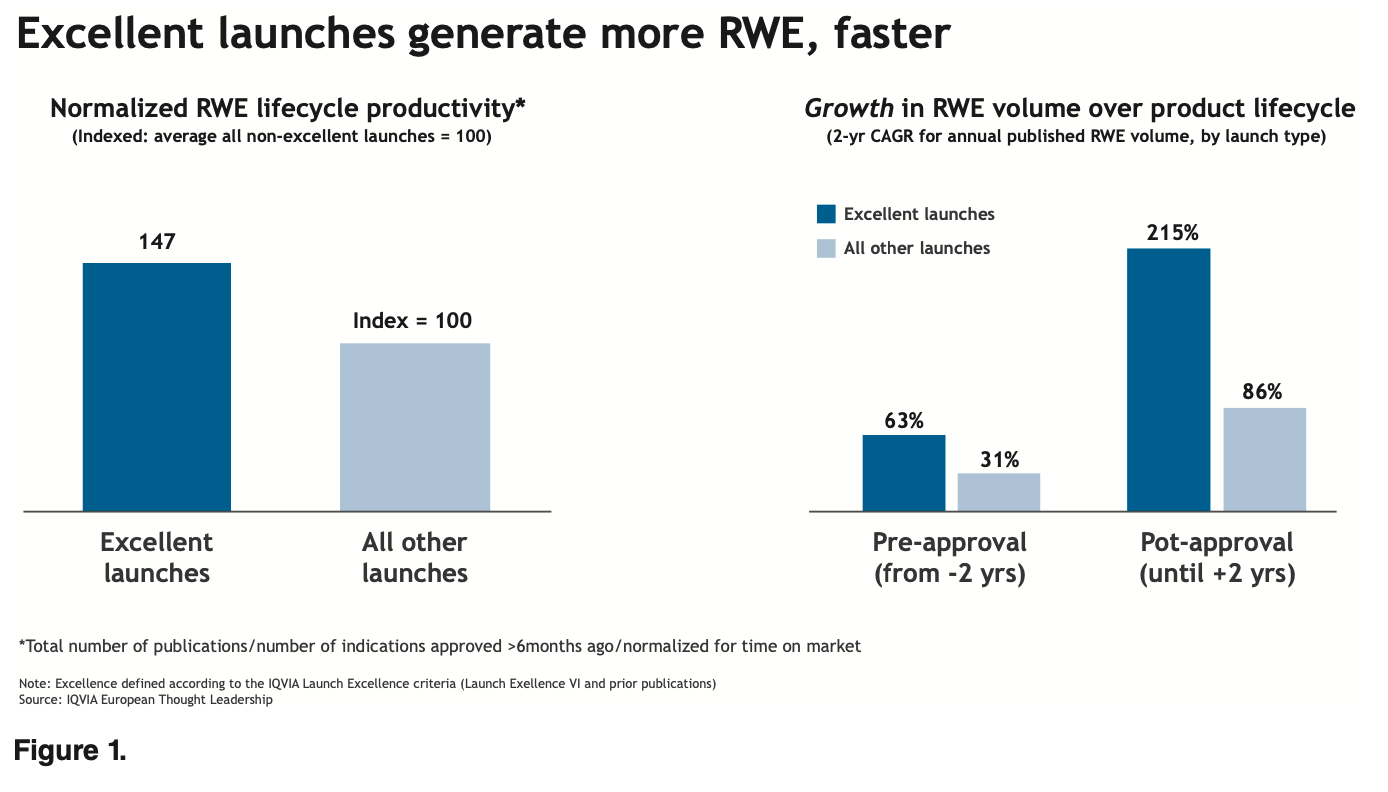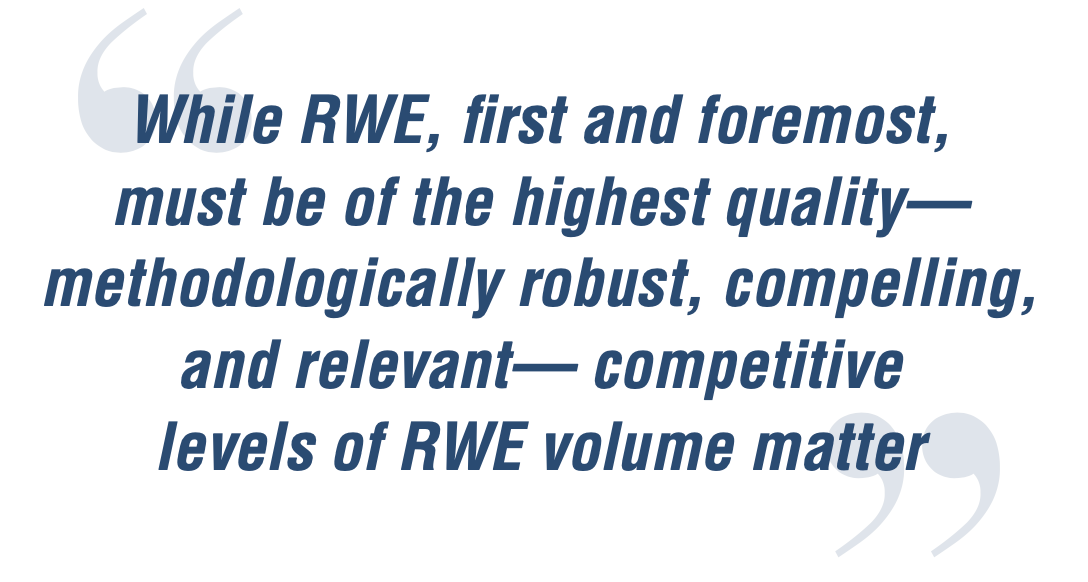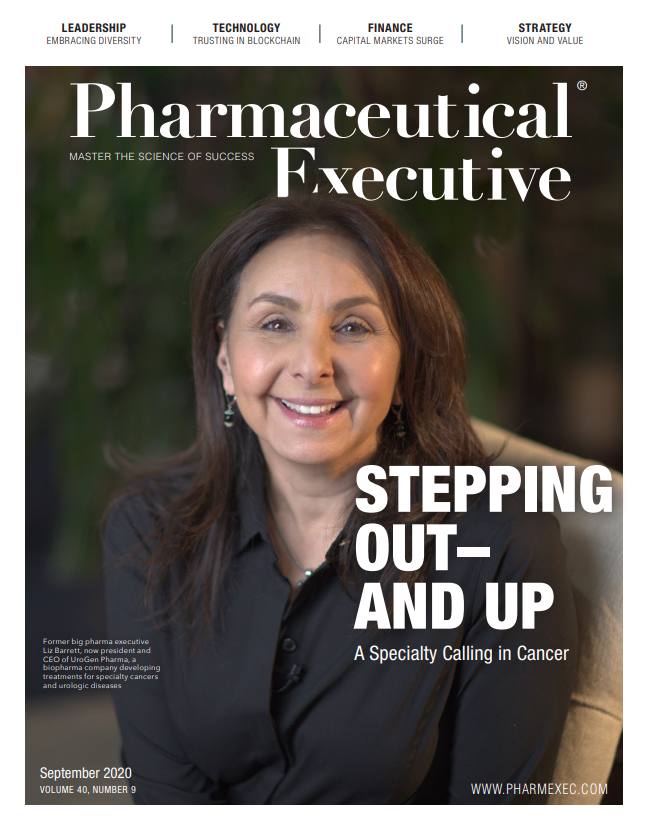Drug Launch: Winning the Evidence Battle
Beyond necessity and nice-to-have, embracing real-world evidence as a true strategic differentiator.
Achieving commercial success with new products has always been a key priority for pharmaceutical companies, yet actually delivering it in a way that meets expectations has never been easy.
Markus Gores

At a fundamental level, a new product must take three hurdles to achieve commercial success:
- Gain regulatory approval.
- Secure market access.
- Be widely utilized in real-world clinical practice.
Evidence plays a key role in overcoming those hurdles: Convincing relevant stakeholders and decision-makers of the benefits and value a new product offers, confirming its safety, and explaining how it fits with current clinical practice and within the existing treatment landscape.
The role of evidence in launch success as such is not new. Generating essential data via randomized controlled trials (RCTs) has always been a fundamental part of the pharmaceutical industry’s new product development model. However, in today’s budget-constrained launch environment the evidence burden continues to rise, as stakeholders demand more information, reflective of a less controlled, real-world setting, as well as increasing levels of “proof,” along the entire product lifecycle.

Real-world evidence (RWE) is uniquely suited to address those demands for additional information. Its distinctive feature of capturing patient-level observations in routine clinical practice, allows RWE to bridge the evidence gap left by RCTs, due to their inherent limitations, such as being highly controlled and thus unrepresentative of real-world patient populations, or practice.
In today’s world, RWE is emerging as a new battle line in the quest for launch excellence.
Bar set high: RWE can help you reach it
In our definition, excellent launches meet three, objectively quantifiable criteria, in two or more countries, during the first two years on the market
- To be among those with the steepest sales uptake trajectories.
- To achieve sales leadership by being consistently ranked in the top decile.
- To outperform their peers by being in the top 20% when sales rank is normalized for competitive intensity faced within the relevant market segment.
As our comprehensive IQVIA Launch Excellence research shows, this represents a very high bar indeed: Fewer than 10% of all launches achieve “excellence” when assessed this way.
Crucially, our latest research highlights the importance of embracing RWE strategically, as a source of competitive advantage: Firms that win the much coveted launch excellence prize consistently generate more RWE, and they do so faster than their peers, before and after product launch (see Figure 1 below).
Click to enlarge

Companies that are most successful at launching utilize RWE strategically. They differentiate their products to regulators, payers, providers, and patients by demonstrating how they deliver measurable value in real-world populations and treatment settings. In addition, they enable providers to optimally use their products in those patient populations that benefit the most. By drawing on deeper insight into the treatment landscape and competitive dynamics, these companies develop superior commercial strategies, such as how to position their brand vs incumbents to exploit unmet needs in a crowded market place.
Used strategically, RWE proactively addresses key healthcare stakeholders’ evidence needs while overcoming the three hurdles to launch success, i.e., approval, access, and real-world utilization.
The competitive dimension of RWE: Quality and quantity
For many, RWE is still largely seen as a combination of necessity and nice-to-have, rather than as a true strategic asset. For example, few companies approach RWE generation with the same strategic mindset as they would, for example, building a competitive promotional in-field presence that sets them apart in a crowded market place.
Yet in today’s launch environment, success depends very much on generating competitive levels of RWE. While RWE, first and foremost, must be of the highest quality—methodologically robust, compelling, and relevant—competitive levels of RWE volume matter.

There is such a thing as share of mind even in the scientific world of evidence. A constant news flow is essential in reminding busy healthcare professionals (HCPs) and payers of key value messages for a product, and this creates more engagement opportunities for sales reps, key account managers, or medical science liaisons (MSLs), simply because there is more to talk about.
Delivering competitive levels of RWE productivity requires a world-class capability, e.g., an evidence platform. Such platforms enable more innovative, novel types of evidence generation, and, therefore, quantity of evidence likely says something about novelty, too.
Furthermore, a world-class evidence capability is underpinned by a network of relationships with third-party dataset owners who are often key stakeholders in local health systems. As such, the evidence capability becomes a collaboration vehicle for engaging and building trust. Again, quantity of evidence is indicative of engagement levels and the quality of a company’s critical relationships with important stakeholders.
Excellent launches embrace the competitive dimension of RWE, and as we have seen, they are winning the evidence (volume) battle.
RWE focus: The right kind of evidence
As a launch product faces different challenges at different stages of its lifecycle, RWE must reflect the different priorities at different points in time. In fact, our research found that companies of excellent launches dynamically align the focus of the RWE they generate with stakeholders’ evolving needs (see Figure 2 below).
Click to enlarge

Specifically, we observed that in the pre-approval period, RWE focus is directed toward market and disease insight categories, such as patient characteristics, disease characteristics, and clinical practice. After approval, once the new product is on the market, health economics and real-world outcomes increasingly move into focus, including comparative effectiveness, safety, and quality of life (QoL). From two years after approval onward, real-world outcomes become the single largest combined category, accounting for just over half of the annual published RWE volume of an excellent launch.
This shift in focus reflects the need to address ongoing stakeholder scrutiny and demonstrate value under real-world conditions, from pre-launch through the post-launch period.
By recognizing this, companies that excel at launching new products ensure the continuous relevance of the RWE they generate, and thus its maximum impact.
A way of life: Starting early, with sustained commitment throughout
An ad hoc approach to evidence generation does not suffice. Instead, companies embracing RWE as a novel source of competitive advantage for launch success develop a best-in-class, integrated lifecycle evidence strategy, which exhibits the following hallmarks:
- It is anchored in a thorough understanding of stakeholder needs that has been validated externally.
- It takes a broad view of opportunities for RWE, considering a wide range of potential use cases, across all healthcare stakeholder types.
- It systematically defines evidence generation and its use, along the entire product lifecycle, starting in the early development phase to ensure the right type and volume of evidence is available at the right time, given the typical lead times for generating evidence.
- It integrates current needs and anticipates future requirements of the different functions within the company. This is a cross-functional effort bringing together development, medical, market access, health economics and outcomes research (HEOR) and commercial.
- It secures early investment in RWE with sustained commitment throughout the lifecycle.
Such a holistic approach firmly embeds RWE at the heart of an organization’s strategic thinking while ensuring its broad relevance across the business, today and in the future.
Unlocking the strategic value of RWE for launch success: Five priorities
To unlock the full strategic potential of RWE for launches, pharmaceutical companies need to address five priorities in the way they approach evidence:
- Elevate evidence generation to a strategic level—ensuring the case for RWE resonates with senior management and key budget holders involved in evidence investment decision-making.
- Approach evidence generation with a competitive mindset, not only thinking about how RWE will differentiate your product clinically, but also how to win the battle for share-of-mind in a noisy and crowded marketplace.
- Develop comprehensive lifecycle evidence plans—putting in place a systematic, cross-functional process, with evidence planning to start early, while anticipating future needs.
- Show conviction and continued commitment to RWE—maintaining competitive levels of investment and differentiating RWE productivity throughout the product lifecycle, until many years after launch.
- Establish a world-class RWE capability as a prerequisite, investing in evidence platforms, building partnerships with third-party dataset owners, participation in evidence networks and embracing innovation in evidence generation, such as “secondary data first” or novel study designs.
By embracing RWE as a true strategic asset and differentiator, pharmaceutical companies will unlock a novel source of competitive advantage. This will serve them well in their quest for launch excellence.
This article was based on a virtual presentation at the IQVIA conference, on demand here.
Markus Gores, Vice President, Thought Leadership, EMEA, IQVIA

The Misinformation Maze: Navigating Public Health in the Digital Age
March 11th 2025Jennifer Butler, chief commercial officer of Pleio, discusses misinformation's threat to public health, where patients are turning for trustworthy health information, the industry's pivot to peer-to-patient strategies to educate patients, and more.
Navigating Distrust: Pharma in the Age of Social Media
February 18th 2025Ian Baer, Founder and CEO of Sooth, discusses how the growing distrust in social media will impact industry marketing strategies and the relationships between pharmaceutical companies and the patients they aim to serve. He also explains dark social, how to combat misinformation, closing the trust gap, and more.